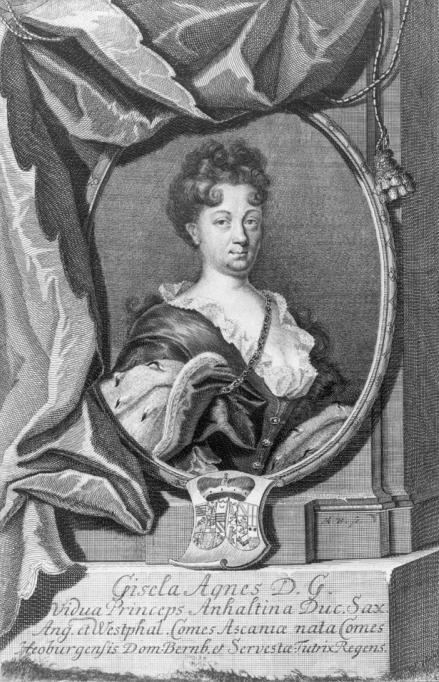Noble family von Rath Parents Balthasar William of Rath | Name Gisela of | |
 | ||
Father Balthasar William of Rath Mother Magdalene Dorothee of Wuthenau Born 9 October 1669Kleinwulknitz, now part of Kothen ( 1669-10-09 ) Buried St. Jacob church in Kothen Children Leopold, Prince of Anhalt-Kothen, Eleonore Wilhelmine of Anhalt-Kothen Grandchildren Princess Bernardina Christina Sophia of Saxe-Weimar-Eisenach, Gisela Agnes of Anhalt-Kothen Similar People Princess Marie‑Auguste of Anhalt, Prince Karl Franz of Prussia, Frederic Prinz von Anhalt | ||
Gisela Agnes of Rath (9 October 1669 in Kleinwulknitz, now part of Kothen – 12 March 1740 in Nienburg) was Duchess of Anhalt-Kothen by marriage from 1692. In 1694, she was created Countess of Nienburg. From 1704 to 1715, she was regent of Anhalt-Kothen for her underage son.
Contents
Life
Gisela Agnes was a member of an ancient aristocratic Lutheran family. Her parents were Balthasar William of Rath, Baron of Kleinwulknitz, and Magdalene Dorothee of Wuthenau. Her paternal grandfather was Wilhelm von Rath; he had commanded the army of Prince Louis I of Anhalf-Kothen during the Thirty Years' War.
The heir to the throne, the young Prince Emmanuel Lebrecht of Anhalt-Kothen fell in love with her. His mother, Princess Eleonore, tried to end this relationship, because Gisela Agnes was considered lower nobility, and unsuitable to marry a ruling Prince. She sent Gisela Agnes to her sister in Stadthagen. However, immediately after Emmanuel Lebrecht had assumed government, he "quietly" married her, on 30 September 1692.
This was a morganatic marriage. Moreover, Prince Emmanuel Lebrecht was a Calvinist and Gisela Agnes was Lutheran. The marriage sparked vehement protest from both the Reformed church and the princely family. Nevertheless, children from this marriage were officially recognized as potential heirs to the throne by the Princes of Anhalt in 1698 and by the emperor in 1699. The later Dukes of Anhalt-Kothen all descend from the "unequal" marriage.
Regency
During his lifetime, her husband had arranged that after his death, she would act as regent for their son Leopold. So when he died in 1704, she took up the regency.
She supported the Lutherans in the principality and founded the St. Agnus church, the first Lutheran church in Kothen. A large portrait of her by Antoine Pesne is still on display in the church. Only a few years later, Johann Sebastian Bach would become a member of this congregation. In 1711, she founded the Gisela Agnes Stift, a secular convent for single noble ladies.
In 1714, a court orchestra was founded, formally by her, but financed by her son Leopold. Initially, the orchestra was composed mainly of former members of the court orchestra in Berlin, which had been dissolved the previous year. The first conductor was the opera composer Augustin Reinhard Stricker. In 1717, he was replaced by Johann Sebastian Bach.
In 1694, Emperor Leopold I elevated Gisela Agnes to "Countess of Nienburg". In 1699, Emmanuel Lebrecht gave her the castle, city and district of Nienburg as a personal possession for life. When the regency ended in 1715, Gisela Agnes withdrew to Nienburg, where she continued to support Lutheranism. She became friends with the theologian and poet August Hermann Francke, who even visited her on her widow seat.
On 24 January 1716, her daughter Eleonore Wilhelmine married in Niehburg to Duke Ernest Augustus I of Saxe-Weimar-Eisenach. It is widely believed that her son Leopold first met the composer Bach during the wedding celebrations.
Gisela Agnes died in Nienburg on 12 March 1740 and was buried in the princely crypt in the St. Jacob church in Kothen.
Issue
Gisela Agnes and Emmanuel Lebrecht had six children:
- Augustus Lebrecht (24 May 1693 in Kothen – 25 October 1693 in Kothen), who died before the recognition of the marriage of his parents as equal and lawful; for this reason, he was never recognized as Hereditary Prince of Anhalt-Kothen.
- Leopold, Prince of Anhalt-Kothen 29 November 1694 in Kothen – 29 September 1728 in Kothen).
- Eleonore Wilhelmine (7 May 1696 in Kothen – 30 August 1726 in Weimar), married on 15 February 1714 to Frederick Erdmann of Saxe-Merseburg (1691-1714), and secondly on 24 January 1716 to Ernest Augustus I, Duke of Saxe-Weimar-Eisenach.
- Augustus Louis, Prince of Anhalt-Kothen (9 June 1697 in Kothen – 6 August 1755 in Kothen).
- Gisela Auguste (24 July 1698 in Kothen – 3 September 1698 in Kothen).
- Christiane Charlotte (12 January 1702 in Kothen – 27 January 1745 in Kothen).
